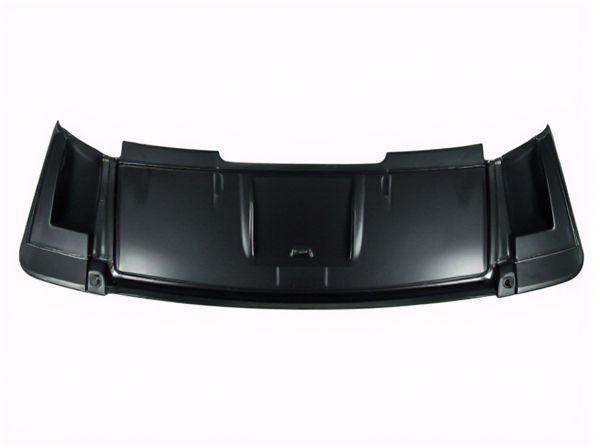
Photo illustration: Decklid vs Tailgate
A decklid is the rear cover of a sedan or coupe that opens upward to provide access to the trunk, while a tailgate is a door or panel at the back of trucks, SUVs, or hatchbacks that typically folds down or swings open for loading and unloading cargo. Understanding the difference between a decklid and a tailgate ensures you use the correct term for your vehicle's rear access point. Choose the right feature based on your vehicle's design and your cargo needs.
Table of Comparison
| Feature | Decklid | Tailgate |
|---|---|---|
| Definition | Rear lid covering the trunk of a sedan or coupe | Rear door that swings down or sideways, mainly on trucks and SUVs |
| Primary Use | Encloses storage space in passenger cars | Provides access to truck bed or cargo area |
| Operation | Lifts upward to open | Typically folds down or swings open |
| Vehicles | Sedans, coupes | Pickup trucks, SUVs |
| Load Support | No load support | Supports loads when opened (e.g., sitting, loading) |
| Examples | Honda Accord decklid, Toyota Camry trunk lid | Ford F-150 tailgate, Chevrolet Silverado tailgate |
Introduction to Decklid and Tailgate
A decklid, commonly found on coupes and sedans, refers to the hinged exterior panel covering the trunk, providing access to the storage space in the rear of the vehicle. Tailgates, on the other hand, are typically used in trucks, SUVs, and some hatchbacks, serving as a larger, often fold-down or swing-open rear door that facilitates loading and unloading cargo. Understanding the distinction between decklids and tailgates is essential for vehicle selection based on cargo accessibility and design preferences.
Definitions: What Is a Decklid?
A decklid, commonly referred to as a trunk lid, is the hinged cover that closes the compartment in the rear of a sedan or coupe, providing access to the trunk space for storage. Unlike a tailgate, which often serves as a door for pickup trucks or SUVs and may fold down to create a flat surface, a decklid typically lifts upward. Decklids are designed to secure cargo while maintaining the aerodynamic profile and sleek design of the vehicle's rear end.
Definitions: What Is a Tailgate?
A tailgate is a hinged door at the rear of a pickup truck or truck bed, designed to fold down for easy loading and unloading of cargo. It often serves as a seating area during outdoor activities or tailgating events. Unlike a decklid, which covers the trunk of a car, a tailgate provides access to the truck's open cargo area.
Key Differences Between Decklid and Tailgate
Decklid refers to the rear hinged cover on sedans and coupes that typically opens upwards to access the storage trunk, designed for a streamlined look and secure closure. Tailgate is the hinged panel at the back of trucks, SUVs, and some hatchbacks that usually opens downward or sideways, providing a flat surface for loading, unloading, or seating. The key differences lie in their orientation, functionality, and vehicle type compatibility, with decklids prioritizing enclosed cargo protection and tailgates offering versatility for cargo handling and exterior access.
Vehicles That Use Decklids
Decklids are primarily used in sedans and coupe vehicles, where they function as a hinged panel covering the rear trunk compartment. Unlike tailgates, which are commonly found on trucks and SUVs and often lower to provide access to a cargo bed, decklids open upward to allow access to enclosed storage areas. Manufacturers like BMW, Audi, and Mercedes-Benz frequently incorporate decklids in their passenger car designs to enhance aerodynamics and secure cargo space.
Vehicles That Use Tailgates
Tailgates are primarily found on trucks, SUVs, and some crossover vehicles, designed for easy loading and unloading of cargo due to their horizontal openness and ability to fold down. Unlike decklids, which are common on sedans and coupes and lift vertically to cover a trunk, tailgates often double as a platform for tailgating activities and provide extended access to the cargo area. Vehicles like pickup trucks, hatchbacks, and sport utility vehicles benefit from tailgates for their versatility and increased cargo space accessibility.
Functional Advantages of Decklid
Decklids provide enhanced security and weather protection by sealing the trunk space more effectively than tailgates, which are typically designed for cargo access on trucks. Their solid construction reduces noise and prevents water ingress, enhancing the overall vehicle durability. Decklids also contribute to improved aerodynamics, supporting better fuel efficiency compared to open or hinged tailgate designs.
Functional Advantages of Tailgate
Tailgates offer enhanced functionality for trucks and SUVs by providing easier access to the cargo area, allowing for convenient loading and unloading of heavy or bulky items. Their horizontal design supports carrying large objects and often includes integrated features such as step assists, storage compartments, and tailgate extenders to increase usability. Compared to decklids, tailgates improve versatility, making them ideal for work, recreational, and transport purposes.
Choosing Between Decklid and Tailgate
Choosing between a decklid and a tailgate primarily depends on vehicle type and cargo accessibility needs. Decklids are typically found on sedans and coupes, offering a hinged lid that opens upward to access the trunk, which suits smaller, enclosed storage. Tailgates, common on trucks and SUVs, often fold down or swing open sideways, providing a larger, flat surface ideal for loading bulky or heavy items.
Conclusion: Decklid vs Tailgate
Decklids and tailgates serve similar functions in vehicles but are designed for different types of vehicle bodies; decklids are typically found on sedans and coupes, providing access to the trunk, while tailgates are common in trucks and SUVs, allowing for easier loading and unloading of cargo. Choosing between a decklid and a tailgate depends on the vehicle type and intended usage, with tailgates offering more versatility for larger, bulkier items. Understanding these distinctions helps consumers select the appropriate vehicle feature for their cargo needs and lifestyle.
 caratoz.com
caratoz.com